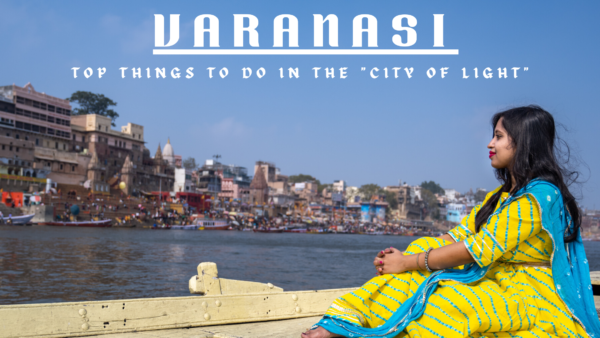“The city illuminates truth and reveals reality. It does not bring new wonders into the scope of vision but enables one to see what is already there. Where this eternal light intersects the earth, it is known as Kashi.” – Diana L. Eck.
Varanasi is the spiritual hub and heart of India. Regarded as one of the oldest cities in the world, Varanasi’s predominant Hindu spiritual ambiance was molded by Parshwanath’s teachings and Gautama Buddha’s first sermons. The songs and poems composed by Kabir and Ravidas, which spearheaded the Bhakti Movement, further added syncretic fervor to the divine world of Varanasi.
Varanasi is, therefore, a kaleidoscope, reflecting a myriad of traditions, customs, and emotions. At first sight, the multitude of activities happening at the ghats and temples, and their resultant cacophony will baffle you. Then, slowly and gradually, Varanasi will captivate you. When you will discover peace amidst the chaotic ghats and crowded alleys, rest assured that the charm of this endlessly fascinating city has done its work on you. As they say, Varanasi “leaves you speechless, then turns you into a storyteller”.
We went through the same. After the initial bewilderment, we were enticed by Varanasi. Whether it’s her famed ghats, ‘galis’, or the Ganga, we couldn’t get enough of Benaras.

Table of Contents
Where is Varanasi located:
Varanasi is located in the southeastern part of Uttar Pradesh. It lies on the left bank of the river Ganges.
The distance of Varanasi from some important places is:
Delhi: 863 km
Kolkata: 689 km
Lucknow: 315 km
Prayagraj: 121 km

About Varanasi:
Varanasi derived its name from two of the tributaries of Ganga – Varuna and Assi. These two crumbling rivers act as the city’s boundaries – Varuna in the north, and Assi in the south.
In the Rigvedic hymns, Varanasi has been referred to as Kashi, which means “city of light”.
Varanasi has got a multitude of other names such as Rudravasa (the place where Rudra or Shiva resides), Avimukta (a place not forsaken by Shiva), and Kashika (the shining place).
The name Banaras or Benaras is probably contorted term derived from the word Varanasi.
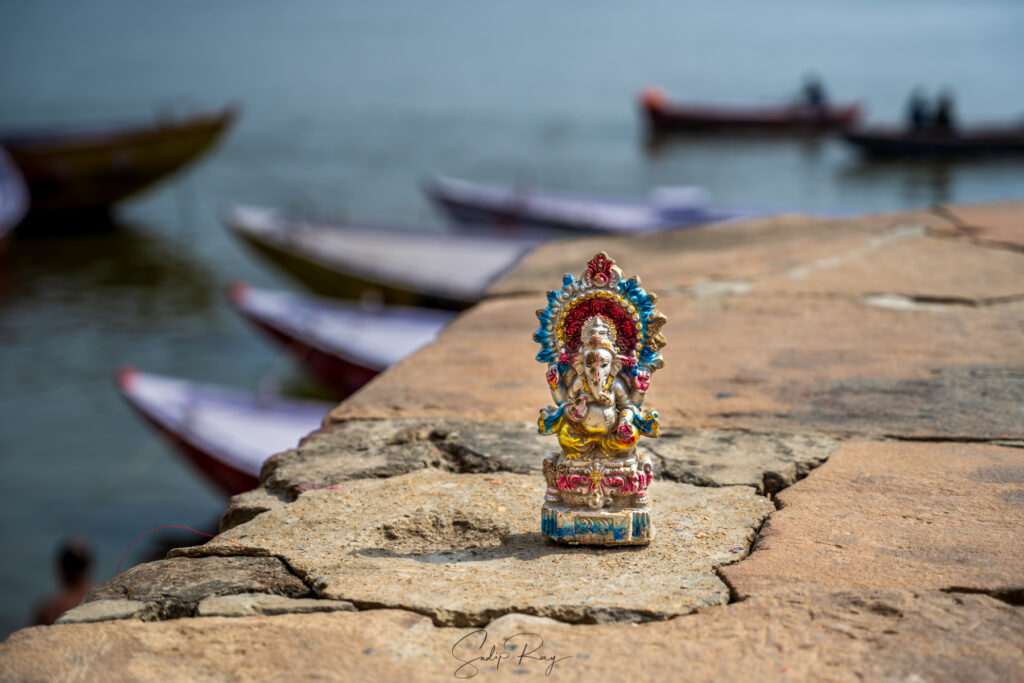
Varanasi in mythology and epic:
As the Hindu mythology goes, the city of Varanasi was founded by Shiva. After marrying Parvati, he began residing here.
Another story mentions a fight between Shiva and Brahma. Shiva appeared as Kal Bhairava, defeated Brahma, and tore off one of Brahma’s five heads. The head clung to Shiva’s hand, and he failed to shake it off his hands. He wandered along the banks of the Ganga with Brahma’s severed head in his hand. At one place, the south-flowing river took a northern turn. At this juncture, Shiva dipped his hand into the river and Brahma’s torn head disappeared. Hence, Kashi came into being as a holy site.
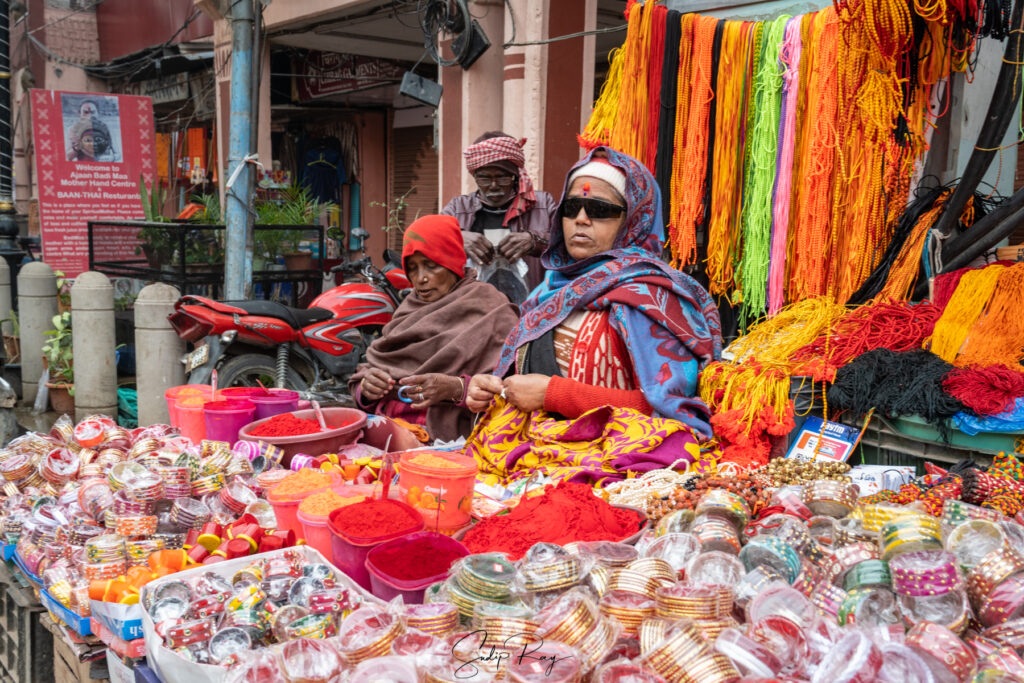
The Mahabharata has multiple references to Kashi. Bhisma had abducted Kashi princesses Ambika and Ambalika for marrying them to the Hastinapur ruler, Bichitrabirjya. Duryodhan had also married a Kashi princess, Bhanumati. Further, after the Kurukshetra war, the Pandavas visited Kahi for atoning their sins of fratricide and Brahma-hatya, or killing of Brahmins.

Varanasi in history
As Mark Twain famously said, Benaras is “older than history”. In fact, Varanasi is one of the world’s oldest cities, where humans have lived since time immemorial.
Archaeological excavations have proved that Varanasi was inhabited even in 1800 BCE.
The 23rd Jaina Tirthankara, Parshwanath, was born in Kashi. Gautama Buddha preached his first sermon at Sarnath, near Varanasi. Varanasi’s religious importance increased manifold when Adi Shankara made Shaivism the primary sect of the city.
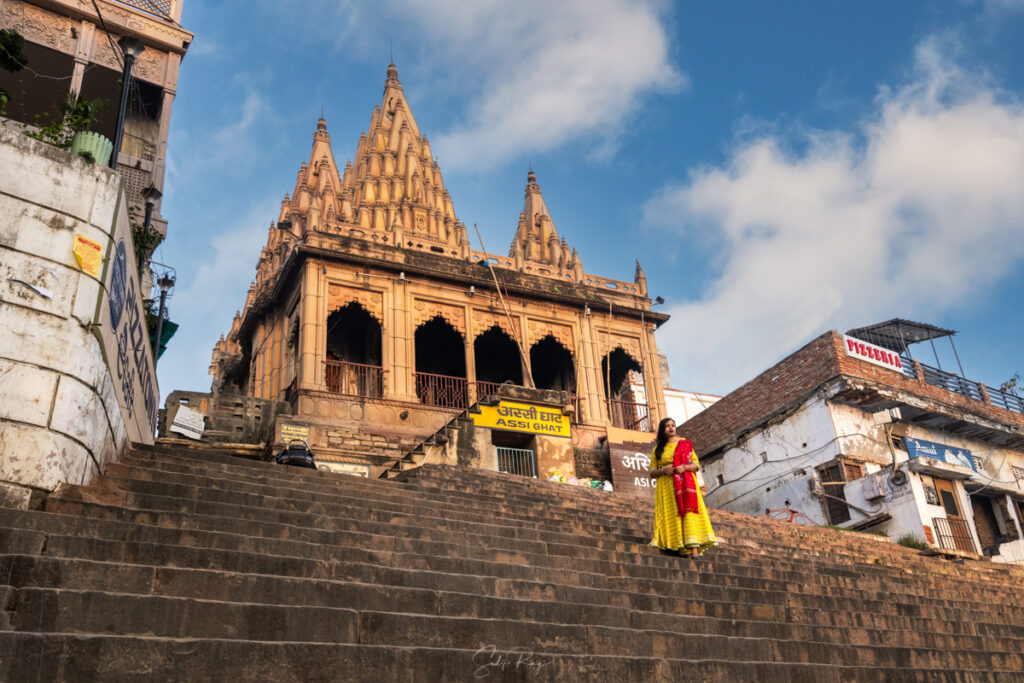
Major figures of the Bhakti Movement such as Kabir, Ravidas, and Tulsidas were born here. Even Guru Nanak, the founder of Sikhism, visited Kashi in 1507. The spiritual aura of Varanasi was greatly influenced by their teachings as well as their literary works.
Along with being a religious center, Varanasi also prospered as an artistic and industrial center, primarily for its silk-weaving culture.

The city continued to flourish until the reign of Aurangzeb who demolished the Vishwanath Temple among other temples. The city revived itself during the 18th century when temples and ghats were constructed and renovated by the Marathas and Bhumihar rulers.
Later, the city was ceded to the British

How to reach Varanasi
Given the significance of Varanasi as a principal pilgrimage center of the Hindus, Varanasi is extremely well connected with the rest of India. You can reach Varanasi by train, plane, and even by road.
Railway: Varanasi can be easily reached by train from anywhere in India. The main stations are Varanasi Junction or Varanasi Cantonment (BSB), Banaras Rail Station (BSBS), and Kashi Rail Station (KEI). Further, the other major rail station is Pt. Deen Dayal Upadhyaya Junction, which was formerly called Mughalsarai Junction. Important trains, such as Rajdhani, stop here. It is just 17 km away from Varanasi. Local buses and auto-rickshaws are available here for reaching Varanasi.
Airway: Lal Bahadur Shastri International Airport is just 26 km away from Varanasi. Daily flights from major cities fly here.
Road: Important National Highways connecting Varanasi are NH 19 (Kolkata to Delhi), NH 7 (Kanyakumari to Varanasi via Bengaluru), and NH 233 (Varanasi to Lumbini in Nepal).

Where to stay in Varanasi
From humble ‘dharamshalas’ and hostels to unique homestays and luxurious heritage hotels, you can find accommodation befitting every pocket in Varanasi.
If you want to stay near the bustling heart of the city, stay near Godowlia Chowk and Dashashwamedh Ghat. Otherwise, opt for Assi Ghat if you want to enjoy peace and quiet.
We earnestly suggest staying by the ghats. It will be a memorable experience to wake up by the Ganga. Also, the ghats will be easily accessible from here. You can check out Hotel Alka near the Rajendra Prasad ghat and Hotel Temple on Ganges (car parking is available within its premise) beside Assi Ghat.
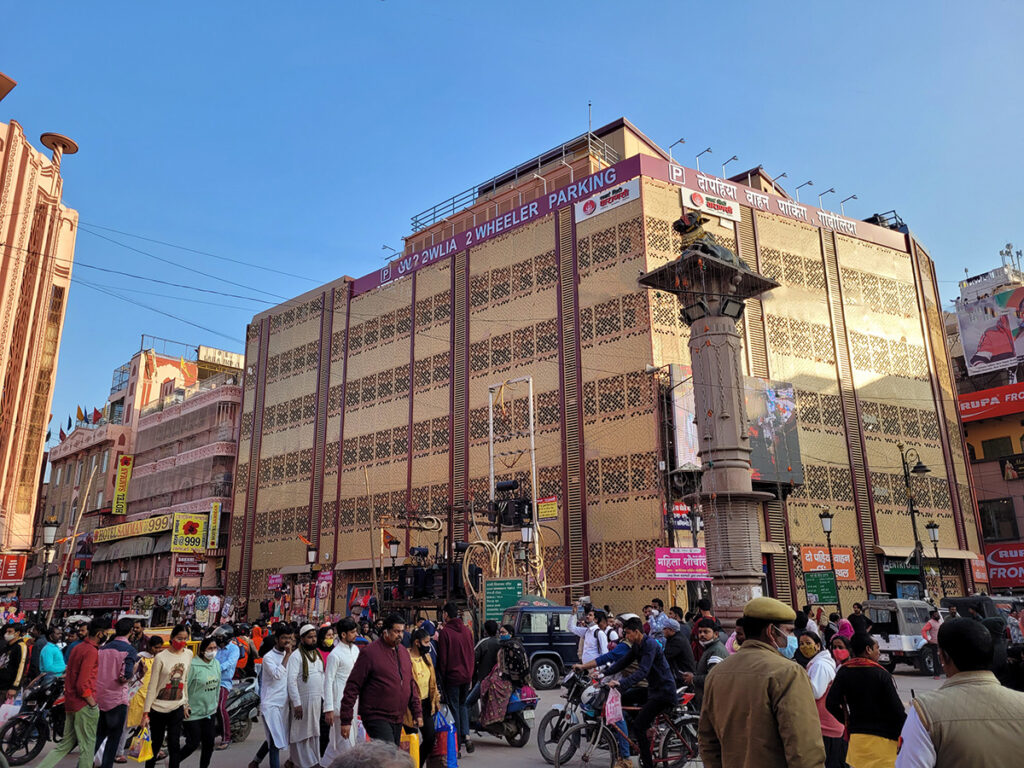
However, if you are visiting Varanasi by your own car (like us), you need to thoroughly check whether the hotel has a parking facility within its premise. We found that parking is a huge issue at Varanasi, and most of the hotels by the ghats do not provide parking.
Hence, we stayed at Shree Ganesha Palace at Girja Chowk (there’s a church near the intersection). Not only has the hotel had ample parking space within its wall, but the Vishwanath Temple is also roughly 400 meters, and Dashashwamedh Ghat is 600 meters from the hotel. Further, auto-rickshaw and pedal rickshaw stands are near, as also the famed eating hotspots.
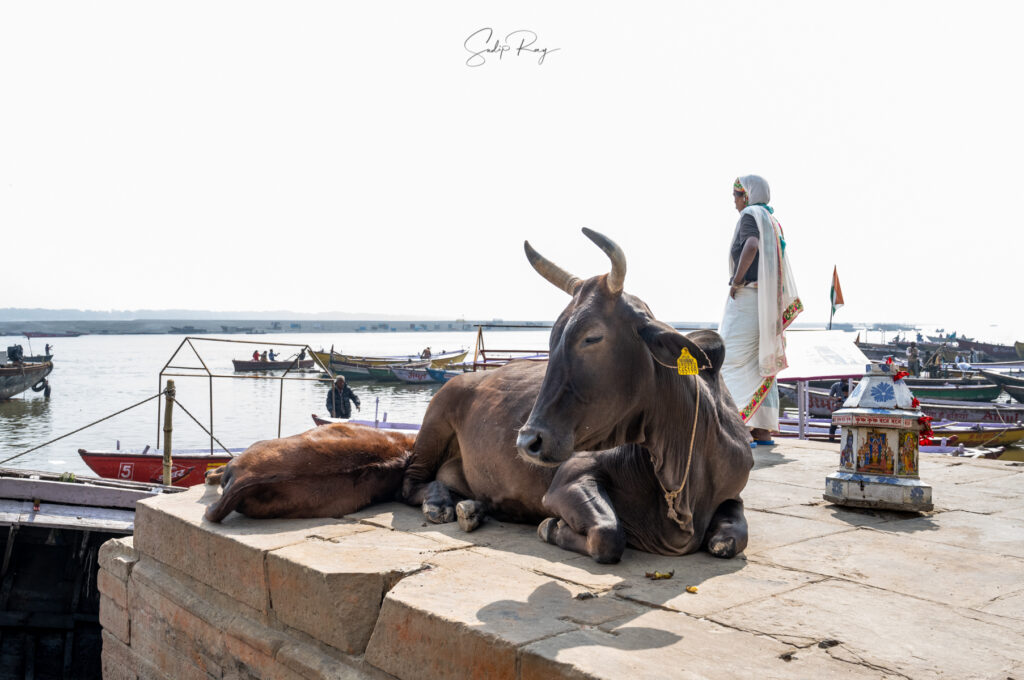
What is the best time to visit Varanasi:
The winter months (November to February) are perfect for traveling to Varanasi. Try avoiding summer, as it’s blazing hot and humid during this time. Avert monsoons too, as the ghats get submerged, and exploration, in general, will be difficult.
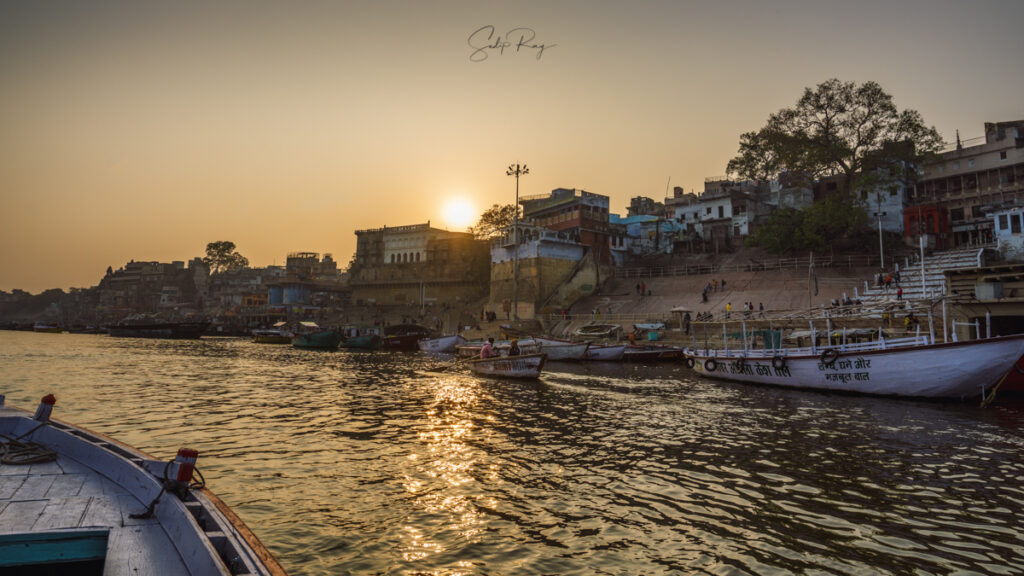
What to do in Varanasi
1. Explore the ghats of Banaras:
There are as many as 84 ghats in Varanasi. And, Varanasi’s heart rests with these ghats. You need to reserve at least a day for exploring the 4 km stretch between Assi Ghat and Manikarnika Ghat. The ghats look and feel divine especially in the early morning and during sunset.
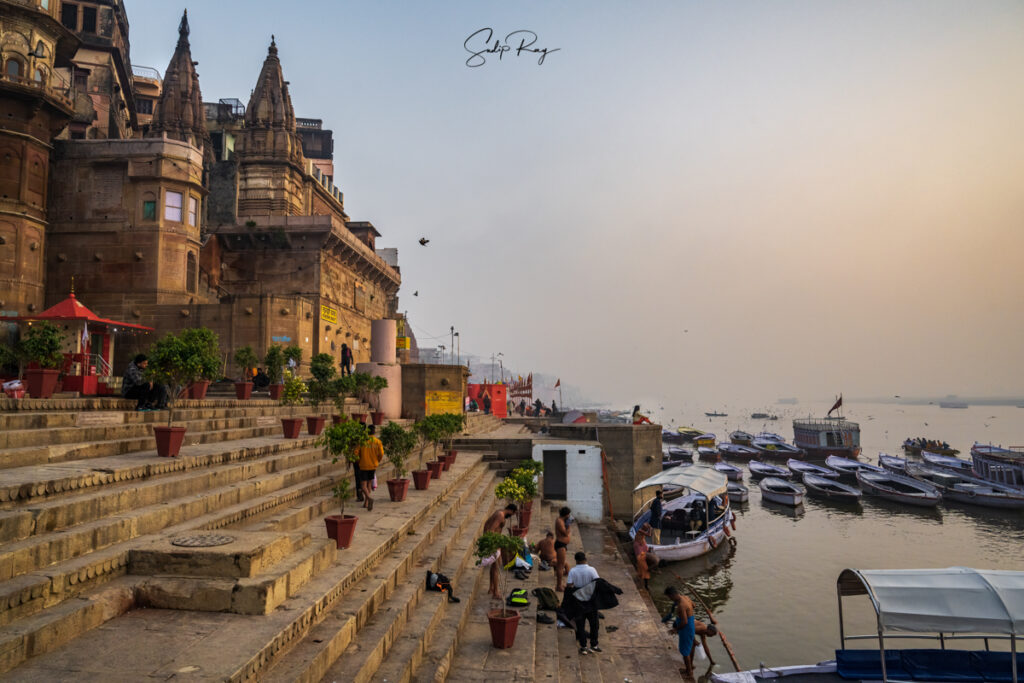
The must-visit ghats are Dashashwamedh Ghat where Brahma performed Dash (ten) Ashwamedh sacrifices, Manmahal Ghat which has the Jantar Mantar and ASI museum, Lalita Ghat which houses the Nepali Pashupatinath Temple, Manikarnika Ghat where last rites and cremation of Hindus take place, Scindia Ghat where the partially submerged Shiva temple stands, Tulsi Ghat where Tulsidas lived and write Ramcharitmanas, Mansarovar Ghat built by Man Singh, Chet Singh Ghat where a magnificent palace lies, Darbhanga Ghat built by Mahataja of Darbhanga and Assi Ghat, the southernmost ghat of Benaras.

2. Boat ride along the Ganga:
A boat ride on the Ganges during sunrise and sunset will surely be etched in your memories forever. This is one of the most magical experiences in Varanasi.

3. Visit the temples:
There is no end to temples in Varanasi. In fact, you will spot a temple at the end of every alley here. Needless to say, a visit to Varanasi remains incomplete unless you drop by some of the innumerable temples of Kashi such as Vishwanath Temple, Durga Mandir, and Sankat Mochan Temple.

4. Watch Ganga Arati at ghats:
After sundown, the ghats of Banaras turn heavenly with the sound of chants, bells, and conch shells, and the smell of incense and camphor as richly clad young priests perform Ganga Arati at Dashashwamedh Ghat. This is a spectacular performance and one of the top draws for anyone traveling to Varanasi.

Ganga Arati takes place in every ghat of Varanasi. They start a little later after the Arati at Dashashwamedh has begun. However, they are less grand as compared to the one held at Dashashwamedh Ghat.
5. Enjoy Subah-e-Banaras at Assi Ghat:
This is a unique program, held every day at Assi Ghat before sunrise. It includes Ganga Arati, chanting of Vedic hymns, playing classical music, and performing yoga.

6. Take a tour of the ‘gali Banaras ki”:
To find the essence of Banaras, you need to get lost in its famed ‘gali’s or alleys. You will find beautiful houses, colorful doors, vibrant shrines, wall graffiti, bulls and cows half asleep, shops selling Lassi, Rabri, and whatnot, people going on with their daily chores, and so many other things.

7. Eat to your heart’s content:
The variety of street food in Varanasi knows no bounds. Hence, after a long walk along the ghats, fuel yourself up with Kachori, chats, Rabri, Lassi, and so on.

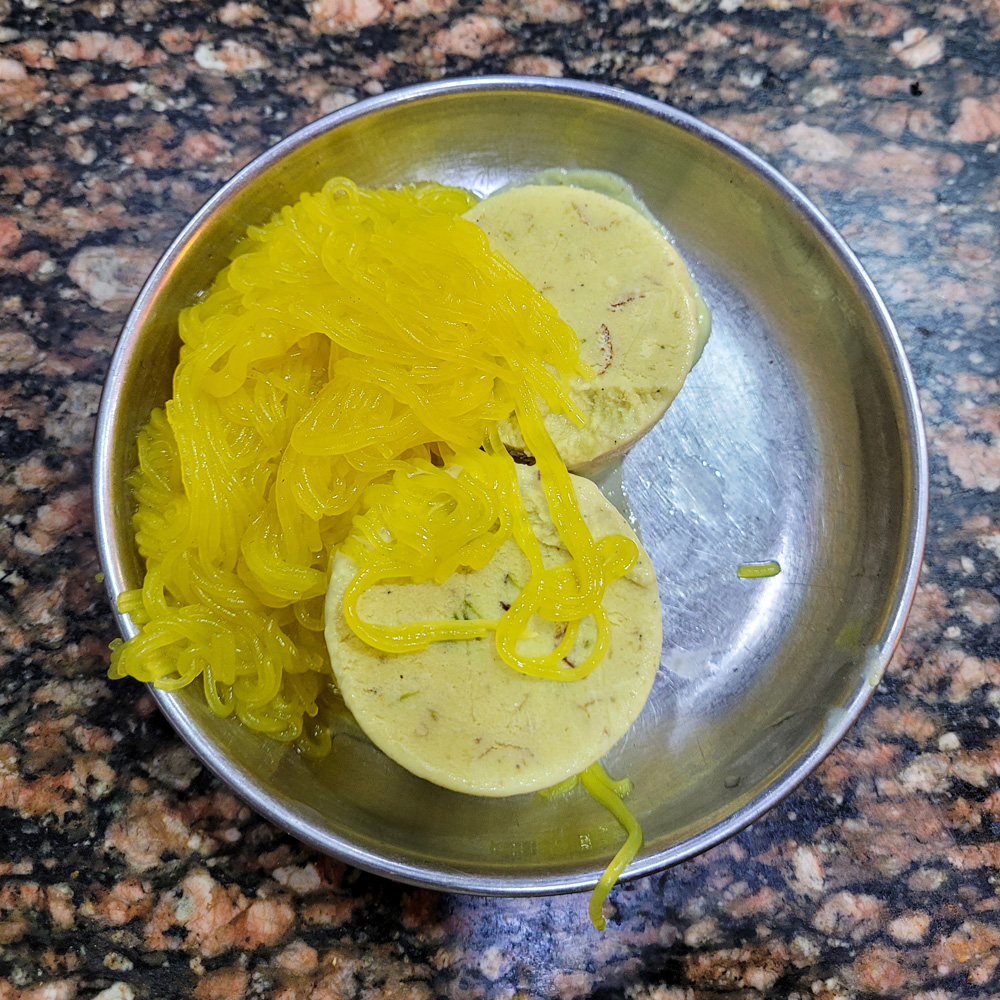

8. Visit the workshop of a Banarasi saree weaver:
The Banarasi is one of the most regal sarees in India. It is also the quintessential part of a Bengali woman’s wedding trousseau. Varanasi is the birthplace of the Banarasi saree. It has even got a GI tag to maintain its authenticity and preserve the art. Try visiting the ‘karkhana’ of weavers and watch how these gorgeous sarees come to life. Also, you can buy saree directly from such weavers at a much lower cost as compared to the shops in the markets.
9. Watch wrestling at ‘akharas’:
One of the most interesting aspects of Varanasi is the ‘akharas’, where wrestling or ‘kushti’ is taught to ‘pahalwans’ or wrestlers. There are a few ‘akharas’ near Tulsi Ghat such as Juna Akhara, Tulsi Akhara, and Swaminath Akhara. You need to reach the ‘akhara’ by 7 in the morning to watch how the wrestlers ready themselves for practice matches. Generally, women are not allowed inside ‘akharas’.
10. Check out graffiti:
While exploring the ghats, ‘gali’s, or market areas in Varanasi, you will be stunned to see excellent graffiti in myriad colors. Go to Prabhu Ghat, Maa Anandamayi Ghat, Reewa Ghat, and Janaki Ghat for some brilliant art. Also, the alley leading to the Manikarnika Ghat has countless graffiti on the walls.

11. Visit Benaras Hindu University (BHU):
One of the largest universities in the world, BHU was founded by Madan Mohan Malaviya in 1916. Since then, it has evolved into one of the premier educational institutes in India. The scenic campus is sprawled across an area of 1370 acres. There is also the new Vishwanath Temple inside the campus, which is believed to be the tallest temple in the world.
12. Take a day tour to Sarnath and Ramnagar Fort:
Sarnath is one of the four holiest pilgrimages of Buddhists. It was here that Gautama Buddha preached his sermon first among his five disciples. Archaeological excavations have unearthed the huge Dhamek stupa and Chaukhandi stupa. There is also an ASI museum here, which displays artifacts excavated from Sarnath, such as Ashoka’s Lion Capital. The museum however remains closed on Fridays. Today, Sarnath is a UNESCO World Heritage Site. It is located 10 km from Varanasi and is surely not to be missed.

The Ramnagar Fort is located on the eastern flank of the Ganga. It was built in 1750 by Kashi Naresh Maharaja Balwant Singh. There is a museum inside the complex, which showcases many old scripts and scriptures, vintage furniture and cars, weapons, and other artifacts. The fort remains open every day from 10 AM to 5 PM.
Which temples to visit in Kashi
There is no dearth of temples in Kashi. In fact, you will find one in every alley and every turn. So, here we are listing the most important temples that one must visit while traveling to Varanasi:
1. Kashi Vishwanath Temple:
Varanasi and Vishwanath are literally synonymous with one another. One of the 12 Jyotirlingas, Vishwanath Temple is one of the most significant Shiva temples in India. The original temple was demolished by Qutubuddin Aiback in 1194 CE. Like the Somnath Temple of Gujarat, Vishwanath Temple was destroyed and rebuilt several times. The present temple was built by Queen Ahilyabai Holkar. The ‘shikhara’ was molded in gold by Ranjit Singh.
2. Durga Kund Temple:
This red-hued temple was built by Rani Bhabani of Natore in the 18th century. It is believed that the Durga idol inside the temple is not man-made, but appeared on its own.
3. Annapurna Temple:
It is dedicated to Annapurna, the goddess of food and nourishment. The original temple was built by Peshwa Bajirao I, near the Vishwanath Temple. At present, the temple is being shifted within the newly constructed complex of Vishwanath Temple.
4. Sankat Mochan Temple:
It is one of the most popular temples and is devoted to Hanuman.
5. Kal Bhairav Temple:
Kal Bhairav is a form of Shiva. He is believed to be the guardian of Kashi. This temple, dedicated to him, lies near the Manikarnika Ghat.
6. Nepali Temple:
Built by the King of Nepal in the 19th century, it is a replica of the Pashupatinath Temple of Kathmandu.
7. New Vishwanath Temple:
This replica of the old Kashi Vishwanath Temple is situated inside the Benaras Hindu University campus.
8. Bharat Mata Mandir:
This temple worships Mother India. It is regarded as one of its kind in the world. Instead of any idol, this temple houses a map of undivided India carved on marble. It is located inside the campus of Mahatma Gandhi Kashi Vidyapith.
What to eat in Varanasi
Apart from being a religious center and historical city, Varanasi is a paradise for any foodie. The array of street food will leave you spoilt with choices. So, we advise you, to stop counting calories and dig into the foods. You can try the following treats:
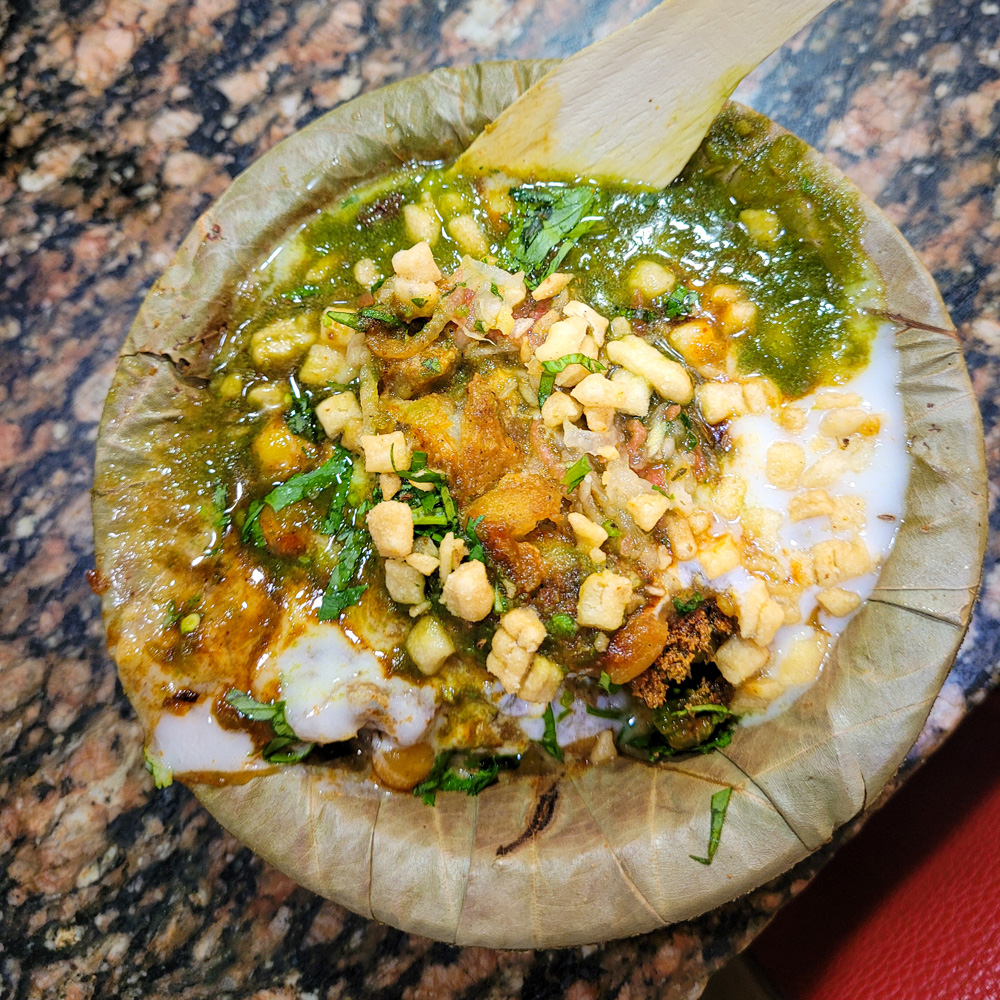
- 1. Kachori-Jalebi: Breakfast in Banaras is incomplete without a plate of steaming Kachori and Sabzi, accompanied by syrupy Jalebis. Kachoris are nothing but stuffed and deep-fried whole wheat pooris.
- The Dashashwamedh galli has many shops, selling Kachori-Jalebi from early morning. Try Madhur Milan at Dashashwamedh galli and Shree Ram Bhandar at Thatheri Bazar.
- 2. Chat: The sheer variety of Chat available in Banaras deserves special mention. Tamatar Char, Bhalla Papdi, Chura Matar, Aaloo Tikki, Palak Patta Chat, Samosa Chat, Papdi Chat, Dahi Bhalla, Khasta Kachori Challa are some of the popular variants.
- Kashi Chat Bhandar and Deena Chat Bhandar dish out the yummiest chats. Both of them are situated at Godowlia Chowk.
- 3. Paani Puri/Gol Gappe: Paani Puri is the champion of Indian street food. It is widely available in Varanasi too.
- You can try Pani Puri from Kashi Chat Bhandar and Deena Chat Bhandar.
- 4. Rabri: Varanasi is renowned for milk and milk products. The Rabri here is lip-smacking. Almost every sweet shop sells Rabri.
- Try the Rabri of Dugdh Sagar at Godowlia Chowk.
- 5. Malaiyo: This is a unique dessert available solely in the winter. It is flavored milk foam, served in small earthen pots and garnished with pistachios and saffron.
- This is an absolute must-try if you are traveling to Varanasi in the winter.
- We enjoyed Malaiyo from Dugdh Sagar.
- 6. Lassi: Countless shops in Varanasi sell creamy Lassi that induces foodgasm. The Lassis are given in earthen pots, topped with a generous layer of Rabri and malai. Lassis are also available in different flavors.
- Check out the Blue Lassi near Manikarnika Ghat for flavored Lassi.
- 7. Paan: No visit to Banaras is complete without having a bite of the “paan Banaraswala”. The paan of Varanasi melts in your mouth, leaving a flavourful aftertaste.
- There are lots of paan shops at Godowlia Chowk, such as Chaurasia Tambul Bhandar.

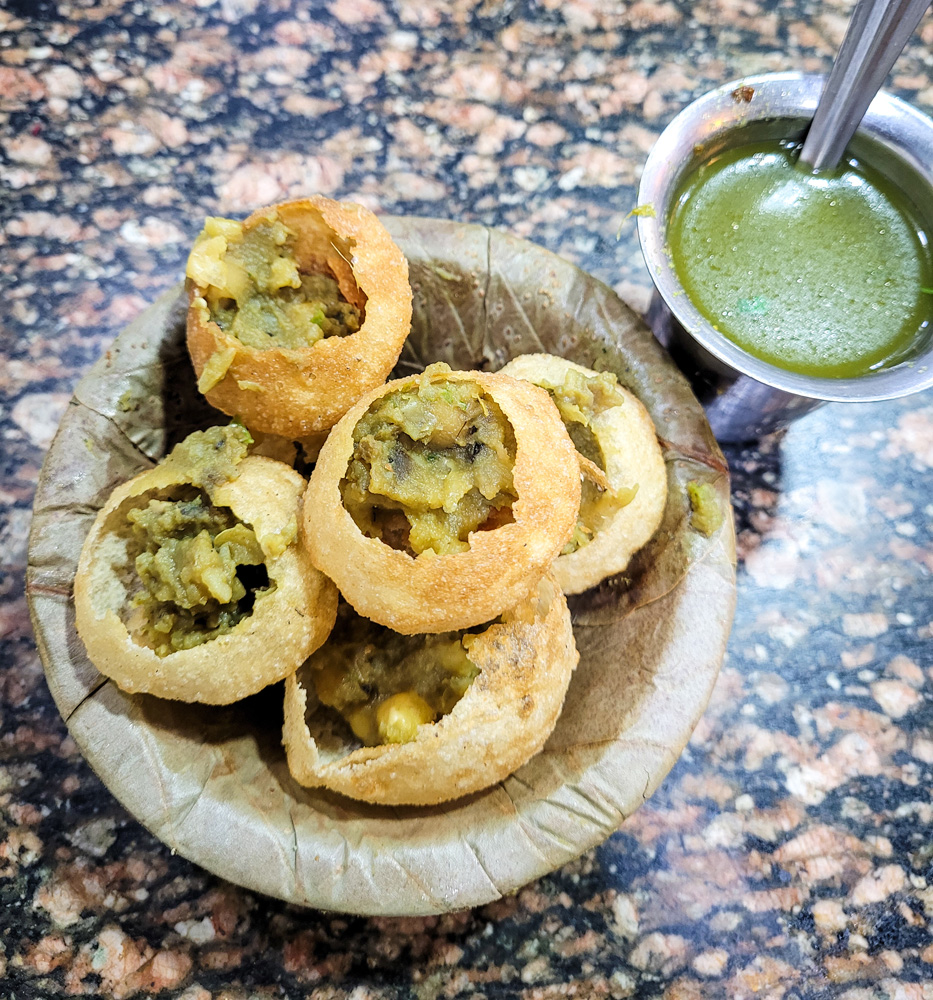
Quick tips:
1. The charges of boats are highest at Dashashwamedh Ghat and its adjoining ghats. The rates decrease considerably as you move south towards Assi Ghat.
Also, boat rates are steepest in the early morning. The rates drop as the day progresses. Boat charges in the morning at Dashashwamedh Ghat range between INR 1500 to INR 1800. This reduces to INR 800 – INR 1000 after 12 PM. As for us, we took a morning boat ride from Assi Ghat to Chet Singh Ghat for INR 500. We also went on an afternoon boat ride from Dwarbhanga Ghat for INR 800. Further, don’t forget to bargain with boatmen. Moreover, try going on hand-driven boats instead of motorboats. In this way, you will enjoy the ride more without adding more pollution to an already polluted Ganges.
2. If you are planning to offer puja at Vishwanath Temple, go as early as possible. The crowd thickens as the day progresses. You can deposit your mobile phones and other valuables at lockers maintained by the temple authority near Gate 1 of the temple. You can also buy Prasad from here.
3. Collective efforts are being continually made at Varanasi to keep the Ganga and her ghats clean. Hence, avoid littering the ghats and throwing plastic particles in the water.
4. Varanasi is heaven for photographers, and the locals seem to understand this. Yet, be careful about the subject of your photography. If anyone objects taking photographs of rituals or cremation, stop immediately.
5. The Ganga Arati at Dashashwamedh Ghat starts at 6 PM after sunset. Reach the ghat as early as possible for securing a vantage position to watch Arati. Also, you can watch Arati from the boats. However, the steps of the ghats offer a better view of Arati as compared to boats.
6. True, Varanasi is a religious pilgrimage centre. In spite of this, there is no dearth of touts and scammers here. They especially target foreign tourists. But Indians are also not immune to them always. If any person tells you that your hotel has been shut down, don’t trust them. Give a cold shoulder to anyone asking you to pay for cremation woods for a poor family. Turn away from men assuring you the best view for Arati in lieu of money. Ignore ‘guides’ and ‘sadhus’ who start telling you the history of Varanasi or the ghats. In short, be careful always.
7. One of the important features of Varanasi is the abundance of saffron-clad ‘sadhus’ or monks. Nonetheless, not all sadhus here have renounced the materialistic world. Hence, you may encounter sadhus, who would demand money after you have clicked their photographs.
8. In addition, Varanasi has plenty of bulls and cows. You will find them everywhere you go. While most of them are calm and mind their own business, maintain a safe distance from them.
9. The traffic in Varanasi is insane. People just don’t follow any traffic rules here. It took us a day to get accustomed to the crazy traffic. It’s sheer luck that we left Varanasi without a scratch on ourselves or on our car.
10. Dress modestly in Varanasi as this is a religious place. Wear clothes that cover your arms, shoulders, chest, and legs.
11. Respect the local culture, customs, and traditions.
